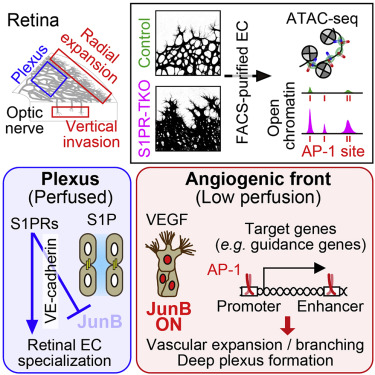Our official English website, www.x-mol.net, welcomes your
feedback! (Note: you will need to create a separate account there.)
Sphingosine 1-Phosphate Receptor Signaling Establishes AP-1 Gradients to Allow for Retinal Endothelial Cell Specialization.
Developmental Cell ( IF 10.7 ) Pub Date : 2020-02-06 , DOI: 10.1016/j.devcel.2020.01.016 Keisuke Yanagida 1 , Eric Engelbrecht 1 , Colin Niaudet 1 , Bongnam Jung 1 , Konstantin Gaengel 2 , Kristina Holton 3 , Steven Swendeman 1 , Catherine H Liu 4 , Michel V Levesque 1 , Andrew Kuo 1 , Zhongjie Fu 5 , Lois E H Smith 5 , Christer Betsholtz 6 , Timothy Hla 7
Developmental Cell ( IF 10.7 ) Pub Date : 2020-02-06 , DOI: 10.1016/j.devcel.2020.01.016 Keisuke Yanagida 1 , Eric Engelbrecht 1 , Colin Niaudet 1 , Bongnam Jung 1 , Konstantin Gaengel 2 , Kristina Holton 3 , Steven Swendeman 1 , Catherine H Liu 4 , Michel V Levesque 1 , Andrew Kuo 1 , Zhongjie Fu 5 , Lois E H Smith 5 , Christer Betsholtz 6 , Timothy Hla 7
Affiliation

|
Transcriptional mechanisms that drive angiogenesis and organotypic vascular endothelial cell specialization are poorly understood. Here, we show that retinal endothelial sphingosine 1-phosphate receptors (S1PRs), which restrain vascular endothelial growth factor (VEGF)-induced angiogenesis, spatially restrict expression of JunB, a member of the activator protein 1 (AP-1) family of transcription factors (TFs). Mechanistically, VEGF induces JunB expression at the sprouting vascular front while S1PR-dependent vascular endothelial (VE)-cadherin assembly suppresses JunB expression in the nascent vascular network, thus creating a gradient of this TF. Endothelial-specific JunB knockout mice showed diminished expression of neurovascular guidance genes and attenuated retinal vascular network progression. In addition, endothelial S1PR signaling is required for normal expression of β-catenin-dependent genes such as TCF/LEF1 and ZIC3 TFs, transporters, and junctional proteins. These results show that S1PR signaling restricts JunB function to the expanding vascular front, thus creating an AP-1 gradient and enabling organotypic endothelial cell specialization of the vascular network.
中文翻译:

Sphingosine 1-Phosphate Receptor Signaling 建立 AP-1 梯度以允许视网膜内皮细胞特化。
驱动血管生成和器官型血管内皮细胞特化的转录机制知之甚少。在这里,我们展示了抑制血管内皮生长因子 (VEGF) 诱导的血管生成的视网膜内皮鞘氨醇 1-磷酸受体 (S1PR) 在空间上限制了 JunB 的表达,JunB 是转录激活蛋白 1 (AP-1) 家族的成员因子 (TF)。从机制上讲,VEGF 在萌芽血管前沿诱导 JunB 表达,而 S1PR 依赖性血管内皮 (VE)-钙粘蛋白组装抑制新生血管网络中的 JunB 表达,从而产生该 TF 的梯度。内皮特异性 JunB 基因敲除小鼠的神经血管引导基因表达减弱,视网膜血管网络进展减弱。此外,内皮 S1PR 信号是 β-连环蛋白依赖性基因(如 TCF/LEF1 和 ZIC3 TF、转运蛋白和连接蛋白)正常表达所必需的。这些结果表明 S1PR 信号将 JunB 功能限制在扩张的血管前沿,从而产生 AP-1 梯度并使血管网络的器官型内皮细胞特化。
更新日期:2020-02-20
中文翻译:

Sphingosine 1-Phosphate Receptor Signaling 建立 AP-1 梯度以允许视网膜内皮细胞特化。
驱动血管生成和器官型血管内皮细胞特化的转录机制知之甚少。在这里,我们展示了抑制血管内皮生长因子 (VEGF) 诱导的血管生成的视网膜内皮鞘氨醇 1-磷酸受体 (S1PR) 在空间上限制了 JunB 的表达,JunB 是转录激活蛋白 1 (AP-1) 家族的成员因子 (TF)。从机制上讲,VEGF 在萌芽血管前沿诱导 JunB 表达,而 S1PR 依赖性血管内皮 (VE)-钙粘蛋白组装抑制新生血管网络中的 JunB 表达,从而产生该 TF 的梯度。内皮特异性 JunB 基因敲除小鼠的神经血管引导基因表达减弱,视网膜血管网络进展减弱。此外,内皮 S1PR 信号是 β-连环蛋白依赖性基因(如 TCF/LEF1 和 ZIC3 TF、转运蛋白和连接蛋白)正常表达所必需的。这些结果表明 S1PR 信号将 JunB 功能限制在扩张的血管前沿,从而产生 AP-1 梯度并使血管网络的器官型内皮细胞特化。











































 京公网安备 11010802027423号
京公网安备 11010802027423号